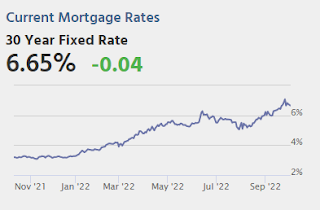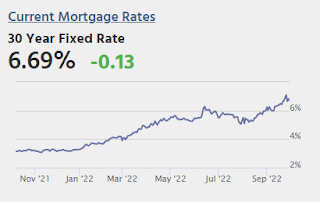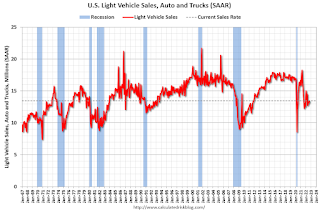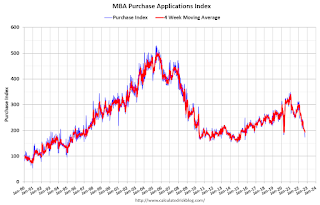by Calculated Risk on 10/05/2022 07:00:00 AM
Wednesday, October 05, 2022
MBA: Mortgage Applications Decrease in Latest Weekly Survey; Purchase Activity Below Pandemic Low
From the MBA: Mortgage Applications Decrease in Latest MBA Weekly Survey
Mortgage applications decreased 14.2 percent from one week earlier, according to data from the Mortgage Bankers Association’s (MBA) Weekly Mortgage Applications Survey for the week ending September 30, 2022.
... The Refinance Index decreased 18 percent from the previous week and was 86 percent lower than the same week one year ago. The seasonally adjusted Purchase Index decreased 13 percent from one week earlier. The unadjusted Purchase Index decreased 13 percent compared with the previous week and was 37 percent lower than the same week one year ago.
“Mortgage rates continued to climb last week, causing another pullback in overall application activity, which dropped to its slowest pace since 1997. The 30-year fixed rate hit 6.75 percent last week – the highest rate since 2006,” said Joel Kan, MBA’s Associate Vice President of Economic and Industry Forecasting. “The current rate has more than doubled over the past year and has increased 130 basis points in the past seven weeks alone. The steep increase in rates continued to halt refinance activity and is also impacting purchase applications, which have fallen 37 percent behind last year’s pace. Additionally, the spreads between the conforming rate compared to jumbo loans widened again, and we saw the ARM share rise further to almost 12 percent of applications.”
Added Kan, “There was also an impact from Hurricane Ian’s arrival in Florida last week, which prompted widespread closings and evacuations. Applications in Florida fell 31 percent, compared to 14 percent overall, on a non-seasonally adjusted basis.”
...
The average contract interest rate for 30-year fixed-rate mortgages with conforming loan balances ($647,200 or less) increased to 6.75 percent from 6.52 percent, with points decreasing to 0.95 from 1.15 (including the origination fee) for 80 percent loan-to-value ratio (LTV) loans.
emphasis added
 Click on graph for larger image.
Click on graph for larger image.The first graph shows the refinance index since 1990.
Note: Red is a four-week average (blue is weekly).
Tuesday, October 04, 2022
Wednesday: ADP Employment, Trade Deficit, ISM Services
by Calculated Risk on 10/04/2022 08:59:00 PM

• At 7:00 AM ET: The Mortgage Bankers Association (MBA) will release the results for the mortgage purchase applications index.
• At 8:15 AM: The ADP Employment Report for September. This report is for private payrolls only (no government). The consensus is for 205,000 jobs added, up from 132,000 in August.
• At 8:30 AM: Trade Balance report for August from the Census Bureau. The consensus is for the deficit to be $68.0 billion in August, from $70.7 billion in July.
• At 10:00 AM: the ISM Services Index for September.
Heavy Truck Sales Up 20% Year-over-year
by Calculated Risk on 10/04/2022 03:37:00 PM
This graph shows heavy truck sales since 1967 using data from the BEA. The dashed line is the September 2022 seasonally adjusted annual sales rate (SAAR).
Heavy truck sales really collapsed during the great recession, falling to a low of 180 thousand SAAR in May 2009. Then heavy truck sales increased to a new all-time high of 570 thousand SAAR in April 2019.
 Click on graph for larger image.
Click on graph for larger image.Note: "Heavy trucks - trucks more than 14,000 pounds gross vehicle weight."
Heavy truck sales declined sharply at the beginning of the pandemic, falling to a low of 308 thousand SAAR in May 2020.
House Prices: 7 Years in Purgatory
by Calculated Risk on 10/04/2022 01:08:00 PM
Today, in the Calculated Risk Real Estate Newsletter: House Prices: 7 Years in Purgatory
A brief excerpt:
However, even in normal times, house prices are not sticky downwards in real terms as this graph shows.There is much more in the article. You can subscribe at https://calculatedrisk.substack.com/
In the July Case-Shiller report, real prices were only up 5.4% year-over-year (YoY) and will likely be down YoY in real terms later this year.
However, we are already seeing nominal house price declines on a national basis. The Black Knight index (median price of a repeat sales index) was off almost 2% in August, and the CoreLogic repeat sales index for August (a three-month weighted average and not seasonally adjusted, NSA) was off close to 1% in August. And my estimate is the nominal Case-Shiller national index will be off almost 1% in August compared to the peak in June.
BLS: Job Openings Decreased to 10.1 million in August
by Calculated Risk on 10/04/2022 10:06:00 AM
From the BLS: Job Openings and Labor Turnover Summary
The number of job openings decreased to 10.1 million on the last business day of August, the U.S. Bureau of Labor Statistics reported today. Hires and total separations were little changed at 6.3 million and 6.0 million, respectively. Within separations, quits (4.2 million) and layoffs and discharges (1.5 million) were little changed.The following graph shows job openings (black line), hires (dark blue), Layoff, Discharges and other (red column), and Quits (light blue column) from the JOLTS.
emphasis added
This series started in December 2000.
Note: The difference between JOLTS hires and separations is similar to the CES (payroll survey) net jobs headline numbers. This report is for August the employment report this Friday will be for September.
 Click on graph for larger image.
Click on graph for larger image.Note that hires (dark blue) and total separations (red and light blue columns stacked) are usually pretty close each month. This is a measure of labor market turnover. When the blue line is above the two stacked columns, the economy is adding net jobs - when it is below the columns, the economy is losing jobs.
The spike in layoffs and discharges in March 2020 is labeled, but off the chart to better show the usual data.
Jobs openings decreased in August to 10.053 million from 11.170 million in July.
The number of job openings (black) were down 5% year-over-year.
Quits were up slightly year-over-year. These are voluntary separations. (See light blue columns at bottom of graph for trend for "quits").
CoreLogic: House Prices up 13.5% YoY in August; Declined 0.7% MoM in August
by Calculated Risk on 10/04/2022 08:00:00 AM
Notes: This CoreLogic House Price Index report is for August. The recent Case-Shiller index release was for July. The CoreLogic HPI is a three-month weighted average and is not seasonally adjusted (NSA).
From CoreLogic: Annual US Home Price Gains Lose Steam Again in August, CoreLogic Reports
CoreLogic® ... today released the CoreLogic Home Price Index (HPI™) and HPI Forecast™ for August 2022.
Although U.S. home prices continued their 127-month run of consecutive annual gains in August, they slowed for the fourth straight month to 13.5%. That’s the lowest year-over-year appreciation recorded since April 2021 and partially reflects continued cooling buyer demand due to higher mortgage rates and housing trends motivated by the COVID-19 outbreak winding down. The 0.7% month-over-month price decrease also indicates reduced homebuyer enthusiasm, with nearly three-quarters of states posting declines from July.
“The increased cost of homeownership has dampened buyer demand and caused prices to decelerate at a faster pace than initially expected,” said Selma Hepp, interim lead of the Office of the Chief Economist at CoreLogic. “Housing markets on the West Coast and in the Mountain West, as well as second-home markets, recorded particularly strong price growth in the summer of 2021 but were the first to see month-over-month price declines during the same period this year. While decelerating price growth and price declines benefit younger potential homebuyers, mortgage rates that are approaching 7% may cut many hopefuls out of the picture.”
...
U.S. home prices (including distressed sales) increased 13.5% year over year in August 2022 compared to August 2021. On a month-over-month basis, home prices declined by 0.7% compared to July 2022.
emphasis added
Monday, October 03, 2022
Tuesday: Job Openings, CoreLogic House Prices
by Calculated Risk on 10/03/2022 08:28:00 PM

Mortgage rates remain elevated in the context of the past decade and 2022 in general, but they continue making progress after hitting long-term highs early last week. ... The average lender is now getting back into the middle to upper-middle 6% range depending on the scenario and the presence of "points" in the loan quote. [30 year fixed 6.69%]Tuesday:
emphasis added
• At 8:00 AM ET, Corelogic House Price index for August.
• At 10:00 AM, Job Openings and Labor Turnover Survey for August from the BLS.
Vehicles Sales Increased to 13.49 million SAAR in September
by Calculated Risk on 10/03/2022 06:37:00 PM
Wards Auto released their estimate of light vehicle sales for September. Wards Auto estimates sales of 13.49 million SAAR in September 2022 (Seasonally Adjusted Annual Rate), up 2.3% from the August sales rate, and up 9.8% from September 2021.
 Click on graph for larger image.
Click on graph for larger image.This graph shows light vehicle sales since 2006 from the BEA (blue) and Wards Auto's estimate for September (red).
The impact of COVID-19 was significant, and April 2020 was the worst month. After April 2020, sales increased, and were close to sales in 2019 (the year before the pandemic).
 The second graph shows light vehicle sales since the BEA started keeping data in 1967.
The second graph shows light vehicle sales since the BEA started keeping data in 1967. Q3 2022 Update: Unofficial Problem Bank list Decreased to 51 Institutions; Search for "Whale" Continues
by Calculated Risk on 10/03/2022 03:56:00 PM
The FDIC's official problem bank list is comprised of banks with a CAMELS rating of 4 or 5, and the list is not made public (just the number of banks and assets every quarter). Note: Bank CAMELS ratings are also not made public.
CAMELS is the FDIC rating system, and stands for Capital adequacy, Asset quality, Management, Earnings, Liquidity and Sensitivity to market risk. The scale is from 1 to 5, with 1 being the strongest.
As a substitute for the CAMELS ratings, surferdude808 is using publicly announced formal enforcement actions, and also media reports and company announcements that suggest to us an enforcement action is likely, to compile a list of possible problem banks in the public interest.
DISCLAIMER: This is an unofficial list, the information is from public sources only, and while deemed to be reliable is not guaranteed. No warranty or representation, expressed or implied, is made as to the accuracy of the information contained herein and same is subject to errors and omissions. This is not intended as investment advice. Please contact CR with any errors.
Here are the quarterly changes and a few comments from surferdude808:
Update on the Unofficial Problem Bank List through September 30, 2022. Since the last update at the end of June 2022, the list decreased by one to 51 institutions after an addition and two removals. Assets decreased by $2.9 billion to $51.5 billion, with the change primarily resulting from a $2.2 billion decrease from updated asset figures through June 30, 2021. A year ago, the list held 59 institutions with assets of $54.9 billion. Added during the third quarter was Unity National Bank of Houston, Houston, TX ($246 million). Removals during the quarter because of action termination included Southwestern National Bank, Houston, TX ($884 million) and Amory Federal Savings and Loan Association, Amory, MS ($74 million).
With the conclusion of the third quarter, we bring an updated transition matrix to detail how banks are transitioning off the Unofficial Problem Bank List. Since we first published the Unofficial Problem Bank List on August 7, 2009 with 389 institutions, 1,785 institutions have appeared on a weekly or monthly list since then. Only 2.9 percent of the banks that have appeared on a list remain today as 1,734 institutions have transitioned through the list. Departure methods include 1,024 action terminations, 411 failures, 280 mergers, and 19 voluntary liquidations. Of the 389 institutions on the first published list, only 3 or less than 1.0 percent, still have a troubled designation more than ten years later. The 411 failures represent 23 percent of the 1,785 institutions that have made an appearance on the list. This failure rate is well above the 10-12 percent rate frequently cited in media reports on the failure rate of banks on the FDIC's official list.
On September 8, 2022, the FDIC released second quarter results and provided an update on the Official Problem Bank List. While FDIC did not make a comment within its press release on the Official Problem Bank List, they provided details in an attachment that listed 40 institutions with assets of $170 billion. In its 2022 first quarter release, the FDIC list had a material $119 billion increase in assets. Since that release, none of the prudential banking regulators – FDIC, Federal Reserve, and OCC – have publicly released an enforcement action detailing an enforcement action against a large institution. The Financial Institutions Reform, Recovery and Enforcement Act (FIRREA) passed by Congress in 1989 requires publication of enforcement actions. See “Supervisory Enforcement Actions Since FIRREA and FDICIA,” published by the Federal reserve Bank of Minneapolis for further details. Prior to FIRREA, enforcement actions were not published by the prudential banking regulators. Section 913 of FIRREA requires public disclosures of enforcement actions. Section 913(2) does allow a delay in the enforcement action publication if “exceptional circumstances” exist. The prudential regulator must make a written determination that publication “would seriously threaten the safety & soundness of an insured depository institution.” The prudential regulator “may delay the publication of such order for a reasonable time.” The section does not define “a reasonable time.” It has been more than six months since that enforcement action was issued, so it seems the primary regulator considers this a “reasonable time” before it informs the public of a large, troubled institution.
Black Knight Mortgage Monitor: "Home Prices Down Again in August ... Now 2% Off June Peak"
by Calculated Risk on 10/03/2022 11:13:00 AM
Today, in the Calculated Risk Real Estate Newsletter: Black Knight Mortgage Monitor: "Home Prices Down Again in August ... Now 2% Off June Peak"
A brief excerpt:
Here is a graph of the Black Knight HPI. The index is still up 12.1% year-over-year but was down almost 1% in August (after a similar decline in July).There is much more in the article. You can subscribe at https://calculatedrisk.substack.com/
• According to the Black Knight HPI, median home prices fell 0.98% in August, only marginally better than July's upwardly revised 1.05% monthly decline
• July and August 2022 mark the largest single-month price declines seen since January 2009 and rank among the eight largest on record
• The housing market has not seen such a significant two-month drop in prices since shortly after the collapse of Lehman Brothers in the winter of 2008




